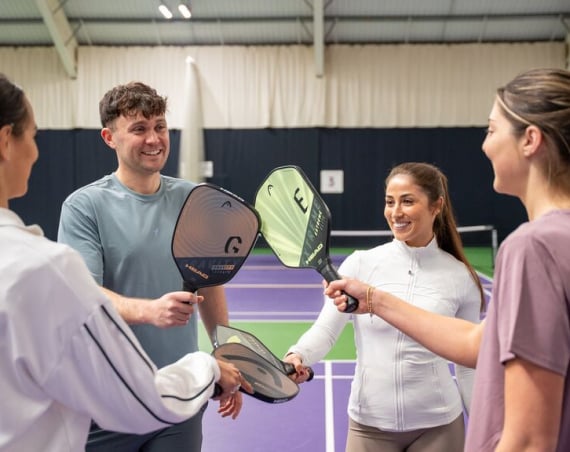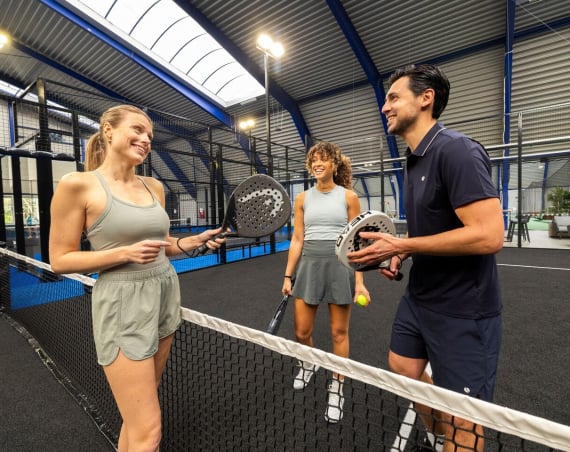Unlike many sports, tennis is a game that can be played across a variety of surfaces. All of these affect how you play. From the speed of points to the way players are able to move, the game can look and feel noticeably different depending on the surface it’s played on.
There are 4 main types of tennis court: hard, clay, carpet and grass. Whether you’re a clay court ace, a specialist ‘serve-volleyer’ or just a natural across all courts, you can enjoy a game across a range of surfaces and in all weathers.
Make sure you’re prepared next time you play on a new surface by reading our guide to what you can expect when stepping onto court:
Hard courts
While there are various different types of ‘hard court’, the focus here is on acrylic courts. Acrylic courts are probably the most versatile type of court, and they can be used both indoors and outdoors. A high number of top level tennis tournaments, including both the US Open and Australian Open, are played on acrylic courts.
It’s viewed as the most consistent surface – meaning your groundstrokes, serves, volleys, stamina and speed are all tested and rewarded. When hit with good levels of spin, the ball will tend to bounce reasonably high, allowing players ample opportunity to judge where they will need to be to return the ball. Acrylic courts are general rated as medium speed.
At David Lloyd Clubs, our acrylic courts benefit from extra cushioning, retaining all of the same play characteristics whilst providing a lower impact surface that is kinder to your body as you move around the court.
Grass or artificial grass
Artificial grass tennis courts are now common across the UK, as tennis players look for durable surfaces to play on throughout the year. Artificial grass plays and reacts much like real grass, though it’s generally more consistent and reliable as it isn’t affected by previous use or growth.
Both grass and artificial grass courts are characterised by the ball ‘shooting through’ with a low bounce and little spin. This means the speed of the game tends to be fast and there is greater emphasis on power and agility close to the net. The ball will also react less to topspin. Grass and artificial grass courts are general rated as fast speed.
Points will generally be shorter, with fewer shots played, but it can be difficult to break serve against an opponent who possesses a fast and accurate serve. (Just ask John Isner and Nicholas Mahut – participants in the longest match to ever take place on the grass of Wimbledon, which included 168 consecutive holds of serve and lasted 11 hours 5 minutes over three days!)
Carpet
Carpet tennis courts provide an alternative indoor surface to play on when the weather isn’t good enough to play outdoors. Carpet plays similarly to grass, and is generally seen as a fast court where the ball will zip off the surface and keep quite low, meaning this surface will generally suit the slightly better player. The speed of the court depends on the age and thickness of the carpet, but when new, a carpet court is generally graded as medium-fast to fast.
At David Lloyd Clubs, our probounce indoor tennis carpet provides a slightly higher slower bounce and a surface that is more responsive to spin, making it a great all round option for players of all abilities.
Wearing specific tennis footwear is advised for all surfaces, though it’s especially important that you wear carpet tennis shoes to avoid any injuries caused by shoes which provide too much grip.
Clay or synthetic clay
Clay tennis courts, recognisable due to their distinctive rusty orange colour, are commonly seen as the slowest type of court. On clay, the ball tends to grip the loose surface slightly more when it hits it, producing a slower, higher bounce. This suits players such as Rafa Nadal, who can create plenty of power and like to hit the ball with lots of topspin. Clay or synthetic clay courts are generally graded as slow courts.
You’ll notice that when playing on clay, the ball will disturb the surface when it bounces, leaving a mark on the ground to allow you to judge where the ball bounced – great for settling those contentious line calls!
Whilst clay courts offer the most friction to affect the ball, the loose nature of the surface offers little grip for a player’s movement, allowing you to slide towards hitting a shot. You’ll need plenty of stamina to excel on clay: points and rallies played on clay courts often last longer as a slower bounce means powerful serves and groundstrokes are less effective.
Other things to think about:
Temperature – On a hot day the ball will fly through the air much faster, whereas if it’s cold, the air will be denser, the temperature of the ball colder, therefore the ball will travel more slowly and the bounce will be lower.
Rain – If it’s wet, the court can become slippery, and the ball will take on some of the water, making it heavier and harder to hit with any speed or spin.
Wind – In windy conditions, it can feel as though you’re playing on two different courts depending on which end you’re at. When hitting into the wind, you’ll need to strike the ball much harder and when playing with the wind, you’ll need to keep the ball lower and try to maintain control.
Thankfully, more ‘outdoor’ courts are now available to play on throughout the year thanks to tennis bubbles which cover courts from the elements – allowing tennis to be enjoyed even in the coldest, windiest and wettest of British weather!
At David Lloyd, you can test your game on over 1000 indoor and outdoor tennis courts across a number of surfaces. Some of our clubs have up to 4 different surfaces to choose from! Develop your game throughout the year, adjusting to the range of variants that different courts provide. You’ll find that playing on different surfaces will help you to become a more rounded player, with a wider range of shots to use.
Find a club



